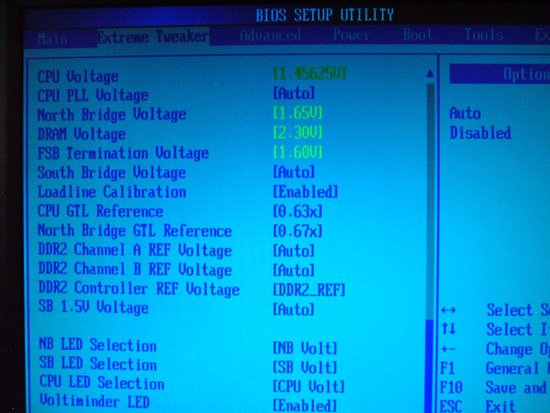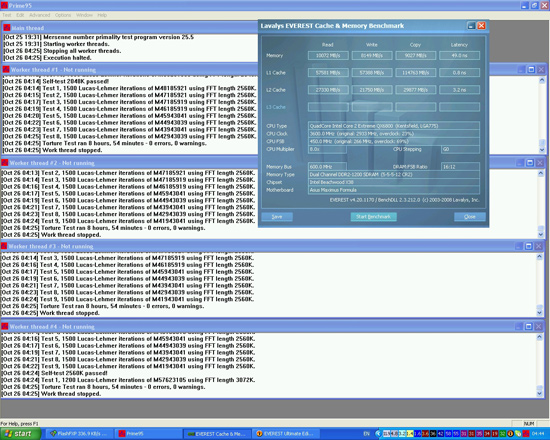ASUS Maximus Formula SE: X38 and DDR2 Unite!
by Rajinder Gill on November 9, 2007 7:00 AM EST- Posted in
- Motherboards
GTL Reference Voltages for Quad-Core Processors

FSB Termination Voltage:
The scale runs from 1.2V-2V in .02V increments. Again, the board overvolts the BIOS setting by around 0.03V-0.04V. We recommend that users do not exceed a setting of 1.56V (1.6V actual) for 24/7 use. As FSB is raised with a quad-core CPU, VTT also needs to be raised. Expect to use between 1.5V-1.6V for overclocks past 440 FSB.
CPU GTL Reference:
Available options are, 0.57x, 0.59x, 0.61x, and 0.63x. This function controls GTL reference voltage to both CPU die's simultaneously. This is not completely ideal as there are always mismatches in CPU fabrication and motherboard components that may require individual GTL voltage level adjustments for each CPU die. The only option of use here is 0.63x, which is actually mislabeled and closer to around 66-67% of VTT. Intel specification for GTL reference voltages is 67%. We probed the on-board voltages with a DMM to find out just how close ASUS is to the 67% mark of VTT.
The closest point to 67% on our motherboard for both CPU die is 1.54V (set in BIOS). Although the differences between actual GTL and Intel 67% specification seem small, fine control of the GTL voltages would have helped the board's overall stability when pushing past 450FSB with the Quad Cores. Each board will have a different level of voltage variance due to on-board component tolerances. In short, a 0.63x setting for GTL at 1.54VTT will not equate to the same measured GTL value on every board and may be adrift from the ideal 67% specification.
NB GTL Reference:
The scale runs from 0.49x to 0.67x in 0.02X increments. 0.67% worked best on our board and processors. We found that values lower than 0.67x caused lock ups and non-boot situations. Again, finer control options would have been nice and should be expected on a board in this price range.
We listed our BIOS settings below for a stable 450FSB run of the Prime95 torture test (8 hours 54mins passed), for those who are interested in this type of stability. Please note that component abilities do vary from board to board; these settings are only an approximate guideline.


FSB Termination Voltage:
The scale runs from 1.2V-2V in .02V increments. Again, the board overvolts the BIOS setting by around 0.03V-0.04V. We recommend that users do not exceed a setting of 1.56V (1.6V actual) for 24/7 use. As FSB is raised with a quad-core CPU, VTT also needs to be raised. Expect to use between 1.5V-1.6V for overclocks past 440 FSB.
CPU GTL Reference:
Available options are, 0.57x, 0.59x, 0.61x, and 0.63x. This function controls GTL reference voltage to both CPU die's simultaneously. This is not completely ideal as there are always mismatches in CPU fabrication and motherboard components that may require individual GTL voltage level adjustments for each CPU die. The only option of use here is 0.63x, which is actually mislabeled and closer to around 66-67% of VTT. Intel specification for GTL reference voltages is 67%. We probed the on-board voltages with a DMM to find out just how close ASUS is to the 67% mark of VTT.
| Voltage Investigations | ||||
| BIOS Set VTT | Measured VTT | BIOS set GTL | Measured GTL | 67% of VTT |
| 1.50 | 1.53 | 0.63x | 1.022 | 1.025 |
| 1.52 | 1.55 | 0.63x | 1.036 | 1.038 |
| 1.54 | 1.57 | 0.63x | 1.051 | 1.051 |
| 1.56 | 1.60 | 0.63x | 1.065 | 1.072 |
| 1.58 | 1.62 | 0.63x | 1.080 | 1.085 |
| 1.60 | 1.64 | 0.63x | 1.090 | 1.098 |
The closest point to 67% on our motherboard for both CPU die is 1.54V (set in BIOS). Although the differences between actual GTL and Intel 67% specification seem small, fine control of the GTL voltages would have helped the board's overall stability when pushing past 450FSB with the Quad Cores. Each board will have a different level of voltage variance due to on-board component tolerances. In short, a 0.63x setting for GTL at 1.54VTT will not equate to the same measured GTL value on every board and may be adrift from the ideal 67% specification.
NB GTL Reference:
The scale runs from 0.49x to 0.67x in 0.02X increments. 0.67% worked best on our board and processors. We found that values lower than 0.67x caused lock ups and non-boot situations. Again, finer control options would have been nice and should be expected on a board in this price range.
We listed our BIOS settings below for a stable 450FSB run of the Prime95 torture test (8 hours 54mins passed), for those who are interested in this type of stability. Please note that component abilities do vary from board to board; these settings are only an approximate guideline.

| 450FSB Quad-Core BIOS Settings | |
| CPU Feature | |
| Ai Overclock Tuner | [Manual] |
| OC From CPU Level Up | [Auto] |
| CPU Ratio Control | [Manual] |
| Ratio CMOS Setting: | [8] |
| FSB Frequency | [450] |
| FSB Strap to North Bridge | [400MHz] |
| PCIE Frequency | [110] |
| DRAM Settings | |
| DRAM Frequency | [DDR2-1199MHZ] |
| DRAM Command Rate | [2T] |
| DRAM Timing Control | [Manual] |
| CAS# Latency | [5] |
| RAS# to CAS Delay | [5] |
| RAS# Precharge | [5] |
| RAS# Active Time | [12] |
| RAS# To Ras# Delay | [3] |
| Row Refresh Cycle Time | [42] |
| Write Recovery Time | [6] |
| Read To Precharge Time | [3] |
| Read To Write Delay(S/D) | [8] |
| Write To Read Delay(S) | [3] |
| Write To Read Delay(D) | [5] |
| Read To Read Delay(S) | [4] |
| Read To Read Delay(D) | [6] |
| Write To Write Delay(S) | [4] |
| Write To Write Delay(D) | [6] |
| DRAM Static Read Control | [Disabled] |
| Ai Clock Twister | [Strong] |
| Transaction Booster | [Enabled] |
| Boost Level | [0] |
| Voltage Settings | |
| CPU Voltage | [1.43125v] |
| CPU PLL Voltage | [Auto] |
| North Bridge Voltage | [1.61v] |
| DRAM Voltage | [2.16v] |
| FSB Termination Voltage | [1.54v] |
| South Bridge Voltage | [Auto] |
| Loadline Calibration | [Enabled] |
| CPU GTL Reference | [0.63x] |
| North Bridge GTL Reference | [0.67x] |
| DDR2 Channel A REF Voltage | [Auto] |
| DDR2 Channel B REF Voltage | [Auto] |
| DDR2 Controller REF Voltage | [DDR2_REF] |
| SB 1.5V Voltage | [Auto] |
| . | |










24 Comments
View All Comments
mbf - Friday, November 9, 2007 - link
...handle DDR2 ECC memory? I for one would like to know. ASUS seems to be of two (or possibly more) minds on the matter stating conflicting information all around the product pages for their respective X38 board offerings. Then again, the P5W DH Deluxe still seems like a smart choice, considering the very small performance delta between the i975x and later chipsets. Also, ASUS claims Penryn support for several of their "mature" offerings, including the P5W DH Deluxe.AnnihilatorX - Friday, November 9, 2007 - link
Personally I would recommend everyone including enthusiasts to not to buy over-priced performance RAMs.And of course looking at price at the moment to choose DDR2 over DDR3
A low latency low frequency RAM are potentially *much* cheaper than a high frequency one. The performance discrepancy is at most 5% which relates to perhaps 2-3FPS in a game. This has probably the lowest cost-to-performance ratio of a system component.
steve4717 - Sunday, May 16, 2010 - link
when will the new bios be ready, and i exspect it, this time to make it possible so it can see, ddr2 1066 at long last.nleksan - Wednesday, November 28, 2012 - link
I have been looking for a motherboard for a recently acquired (given to me free of charge) set of somewhat older but almost entirely unused (i.e. no more than 100hrs use on anything, most have around 20-40hrs; came from 9 different full-or-partial PC's) hardware including:- Core2Duo E8600 (under 20hrs use, known to run stable at 4.5Ghz on air, 4.9Ghz on water)
- 4x2GB G.Skill DDR2-1066/1150 4-4-4-9
- 4x1GB OCZ DDR2-1066 4-4-4-12
- 3x 250GB Samsung Spinpoint SATA3Gbps HDD's
- 2x 150GB WD VR SATA3Gbps 10krpm HDD's
- 1x WD WD800BB 80GB SATA3Gbps HDD
- 4x WD2500JB 250GB SATA HDD's
- 3x WD Caviar Blue 320GB (AAKS) SATA3Gbps HDD's (repurposed for new X79 build)
- 2x Seagate 7200.7 160GB E-IDE HDD's
- 3x Hitachi Deskstar 320GB SATA3Gbps HDD's
- Enermax 690W High-Efficiency PSU
- Antec SOHO Server Case with 8x3.5" bays/5x5.25" bays (fits a Xigmatek 4x3.5-in-3x5.25 with 120x25mm fan converter nicely, for a total of 12xHDD's) and ripe for some heavy modifications
OR
- Thermaltake XASER V Limited Edition with 5x3.5" bays + 6x5.25" bays
OR
- Buy a new sub-$100 case for this (Rosewill ThorV2 would be nice for price, Antec 1100/1200/P283
- DD Maze6 CPU Block
- 2x DD Maze6 GPU Blocks
- 3x Swiftech MCW82 GPU Blocks
- Laing DDC3.25 + 2x Laing D5 Vario Pumps
- Swiftech MCRES-Rev2
- HWL Black Ice GTX 360 rad
- HWL Black Ice GTS 280 rad
- 4x Misc 120-240 Rads
- 11x Delta Fans (7x 120x38mm 2200-4500rpm up to 133cfm 14.25mmH2O, 4x 120x25 2400-4800rpm up to 155cfm 15.2mmH2O)
- 5x NIDEC Fans (120x38mm 0.98amps 11.5-13.2V, up to 4250rpm 151cfm 22.32mmH2O)
- >50x Misc 80x15/25/38mm, 92x25/38mm, 120x12/25/38mm, 140x25mm Fans
I have been looking for two things: a Motherboard and a GPU (or pair of GPU's), and while this will be a Home Server/Media Server, it will also function as a F@H box. I am thinking that 2x 9800GTX+'s or 2x GTX260 216core's in SLI would suffice, but perhaps not? I don't know much about the C2D/C2Q era MB's/GPU's....
I have been looking at the following boards:
- Asus P5Q Premium (huge amount of connections, would allow 4x GPU's for F@H or 3xGPU + 1x RAID Card)
- Asus Maximus Extreme
- Asus Rampage Extreme
For GPU's, I've been really considering the following, from lowest cost to highest:
- 2-3x 8800GTS 512MB (G92)
- 3x 8800GTX's
- 2-3x 9800GT's
- 2-3x 9800GTX+'s
- 2x 9800GTX2's
- 2-3x GTX260(216core)-to-GTX295's
- 2-3x GTX460's-to-GTX480's
Anyone remember enough about this older hardware to help me out?